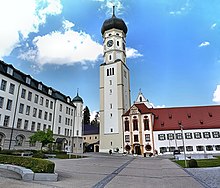Ursberg Monastery
|
Territory in the Holy Roman Empire |
|
|---|---|
| Reichsstift Ursberg | |
| coat of arms | |

|
|
| Alternative names | Imperial Abbey |
| Ruler / government | Reich Abbot |
| Today's region / s | DE-BY |
| Parliament | In the Imperial Council , represented by the Swabian kingdom prelate College |
| Reichskreis | Swabian Empire |
| Capitals / residences | Ursberg |
| Denomination / Religions | Roman Catholic |
| Language / n |
German , Latin
|
| Incorporated into |
Electorate of Bavaria
|
The Ursberg Monastery is a former imperial abbey of the Premonstratensian and today's monastery of the Franciscan St. Joseph Congregation in Ursberg ( Günzburg district , Bavaria) in the diocese of Augsburg .
history
The monastery, consecrated to St. Peter and St. Johannes Evangelist, was founded in 1125 by the noble Wernher von Schwabegg-Balzhausen. It was the first settlement of the Premonstratensian Order in southern Germany. The monastery became an imperial monastery in 1143. Ursberg Monastery founded the still existing Roggenburg Monastery as early as 1126 . In the 18th century, there were rational reforms in the land and judicial rule , which, however, did not lead to the enactment of a separate policey order until 1777 . It regulated the internal order of the Swabian imperial monastery, from the Sunday and public holiday order to regulations for visiting taverns to the prohibition of gambling for the monastery subjects.
In 1803 the monastery was dissolved in the course of secularization . The church became a parish church. The rectory and the Ursberg regional court were housed in the monastery. In 1884, the priest Dominikusringenisen acquired the building and established a congregation of sisters there to care for the physically and mentally handicapped, today's Dominikus -ringenisen-Werk . This institution was supported by the St. Joseph Congregation Ursberg, a Franciscan religious order with around 180 sisters.
From 1936 onwards, over 200 patients were forcibly sterilized during National Socialism . From autumn 1940 to August 1941, almost 200 people were brought to the Nazi killing center in Hartheim near Linz for gassing . Another 200 or so patients died of starvation and neglect by 1945. A memorial by the sculptor Alfred Görig, born in 1947, in the cloister courtyard has been a reminder of this chapter since 2004, as well as of the dead from both world wars. A memorial plaque in Hartheim Castle in Upper Austria takes up the central motif of the memorial in the Ursberg cloister courtyard and commemorates those murdered during the 3rd Reich in institutions of the St. Joseph Congregation.
In 1996 the plant was converted into a church foundation under public law. The foundation supports people with disabilities in numerous places in Bavaria.
Manorial rule
At the beginning of the 19th century, the Ursberg lordship comprised 3300 subjects. Despite his imperial status, Ursberg was one of the poorest prelate monasteries in Swabia . After secularization, rule fell to the Electorate of Bavaria , in whose place the Ursberg Regional Court was established in 1804. The rulership was once composed of the following localities: Ursberg , Mindelzell , Billenhausen , Haslach , Bayersried , Oberrohr , Edenhausen , Attenhausen , as well as three hamlets and free float.
Provosts and abbots of the monastery
Monastery church
literature
- Alfred Lohmüller: Reichsstift Ursberg: From the beginnings in 1125 to 1802 , 1987, ISBN 978-3-87437-249-7
- Wolfgang Wüst (ed.): The "good" Policey in the Reichskreis. On the early modern setting of standards in the core regions of the Old Reich , Volume 1: Der Schwäbische Reichskreis, with special consideration Bavarian Swabia , Berlin 2001, pp. 359–382 (Ursberger Policeyordnung), ISBN 3-05-003415-7
- Jacques Gélis: Signs of Life - Signs of Death. The miraculous baptism of stillborn children in Enlightenment Germany. In: Jürgen Schlumbohm et al. (Ed.): Rituals of childbirth. A cultural story. Munich 1998, pp. 269-288.
Web links
- Franciscan Sisters of the St. Joseph Congregation
- Premonstratensian Order
- Ursberg Monastery , basic data and history: Ursberg - Premonstratensians and Sisters of Joseph in the database of Monasteries in Bavaria in the House of Bavarian History
Individual evidence
- ^ [1] House of Bavarian History: Ursberg Monastery
- ↑ Warning board in Hartheim Castle
- ^ House of Bavarian History - Monasteries in Bavaria. Retrieved January 2, 2019 .
Coordinates: 48 ° 15 ′ 58 " N , 10 ° 26 ′ 47.1" E



